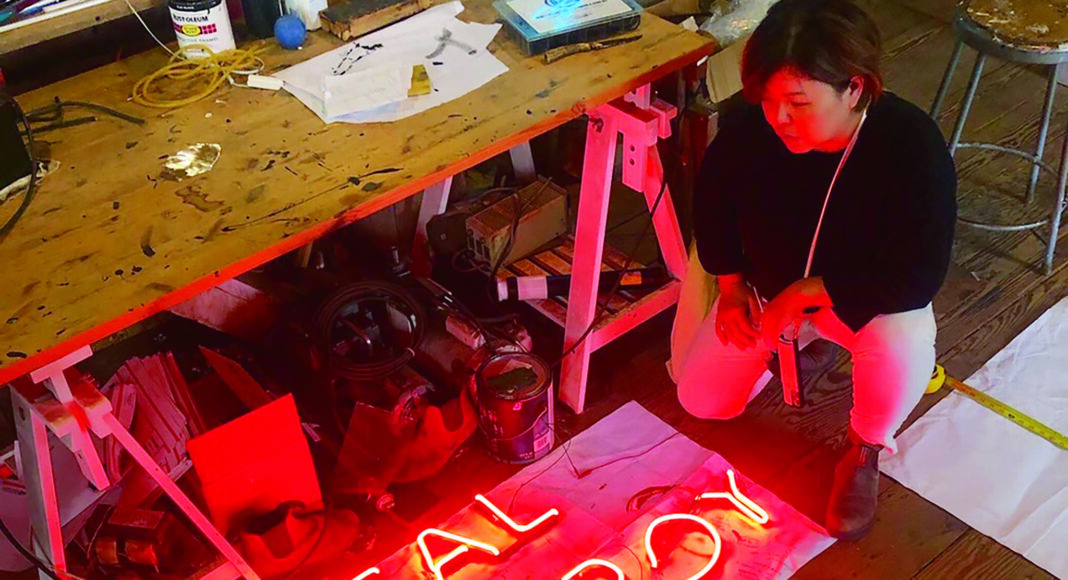Like the mythological beings she depicts, Bay Area artist Masako Miki is always changing form.
A painter and sculptor who’s worked with bronze, vinyl, wool, washi paper and more, Miki’s upcoming exhibition at Institute of Contemporary Art San Jose, titled Shapeshifters, will feature a facade on the front of the museum, the newest installment in ICA’s Facade Project. The mural takes its title Night Parade of 100 Demons from an event in Japanese folklore where hundreds of yokai—often translated as spirits or deities who take on humanoid and animal forms—flood the streets, causing pandemonium.
Miki describes some of the yokai who populate her watercolors and sculptures: the fox, for example, is a well-known trickster and protector. Some yokai are spirits of items that have been discarded, such as “a cherished plate that you love, or textile handed down as an heirloom…objects people use every day for a long time. They look like they’ve been thrown away, and then they get up and march together.”
The Shapeshifters show incorporates a menagerie of media to tell an ancient story, including an AR component where viewers can watch yokai animate on their screens. Miki is also using neon for the first time, collaborating with local neon studio She Bends, a women-led organization that also leads workshops and educational programs. She Bends’ founder Meryl Pataky will help Miki execute a piece inspired by the sign for San Jose’s first Japanese-owned business in 1929, Ideal Laundry in Japantown. Like the yokai of old beloved objects, Miki’s neon sign re-animates an original anchor of the historic neighborhood.
A 2001 graduate of SJSU’s MFA program, Miki has fond memories of Japantown from her time as a student.
“I lived by there, I bartended part-time at 7Bamboo…and I sang, but not well,” Miki laughs as she recalls her stint at the long-standing karaoke bar. “I really enjoyed the diversity of the city. San Jose, in a sense, it really represents the Bay Area. Many immigrants live there, and it’s a huge part of it.”
However, as the years progressed, the artist noticed a rise in the city’s income inequality, which she first became aware of while in school.
“I remember looking for food and it was hard to find something between $50 meals and fast food,” Miki says. “I met so many incredible people in school here. I really enjoyed the diversity of the city. [But] it’s becoming more pronounced that there’s no middle class in San Jose.”
While at SJSU, Miki enjoyed the size of the program for the variety of people she met and the paths they followed. Her on- and off-campus education planted the thematic seeds she’d explore with Shapeshifters years later, of individual and communal identities and the ways we adapt them.
At the project’s outset Miki says it “started as more [of an] identity question.” She began developing Shapeshifters and exploring yokai in 2016, as part of a wider research venture into the cultural heritage of her native Japan.
“You can’t really categorize them. They’re not human, they’re not gods…they’re somewhat deities, and then they become objects. The fluidity echoes, to me, how I survive by shapeshifting, to navigate this contemporary time. We have fictions—politics and social agendas—that dictate our reality, but our reality isn’t a fiction, it causes real pain. So I feel like we need to rebuild our mythologies.”
In today’s cycle of relevance and obsolescence, the idea of an object’s inherent spirituality carries a particular poignancy, a valuable reminder to reconsider what (and who) society considers disposable. While San Jose morphs and squeezes out its middle class, there’s still the possibility to shift into a more equitable city. Key to this transformation is recognizing qualities that have been there all along.
“I really believe that shapeshifting and being fluid is the only way to survive in this rapidly changing society. Everything is somewhat uncertain for us now, but I think it’s an opportunity to become something unexpected.”
Night Parade of One Hundred Demons
Opens Fri, 12pm, Free
ICA San Jose, San Jose



